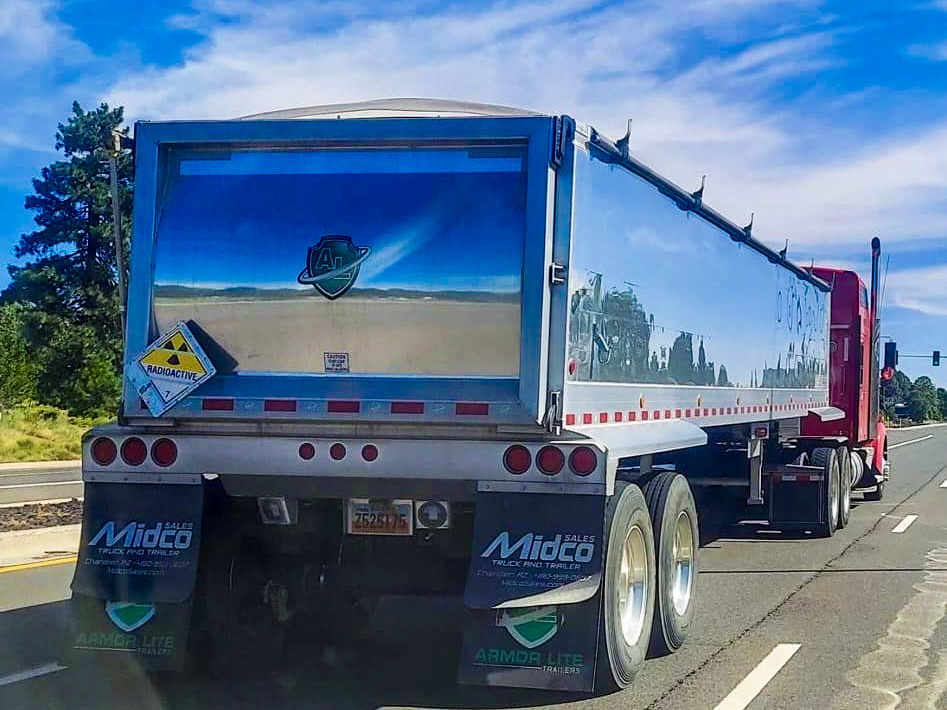Indianz.Com > News > Cronkite News: Navajo Nation asserts authority over uranium shipments

Navajo Nation strengthens rules on uranium transportation as negotiations continue with Energy Fuels Inc.
Monday, September 23, 2024
Cronkite News
WASHINGTON — The first shipment of uranium ore from the new Pinyon Plain Mine near the Grand Canyon began rumbling through Navajo land on July 30 — outraging tribal leaders.
They knew the shipments were coming, but had expected a heads-up from Energy Fuels Inc., especially given the tribe’s painful history of radiation exposure from uranium mining and nuclear bomb tests.
In late August, the Navajo Nation Council adopted legislation requiring a week’s notice before any future shipment from the mine to a mill in southern Utah.
The company is taking steps to appease the tribe. It has promised notice before future shipments, and is negotiating voluntary transit fees, even though tribal officials concede they can’t enforce the demands.

2012 Radiation Materials Transportation Act is strengthened in a new legislation signed into law WINDOW ROCK, Ariz. –…
Posted by Navajo Nation President Buu Nygren on Thursday, August 29, 2024

Note: This story originally appeared on Cronkite News. It is published via a Creative Commons license. Cronkite News is produced by the Walter Cronkite School of Journalism and Mass Communication at Arizona State University.
Related Stories
Search
Filed Under
Tags
More Headlines
Native America Calling: The Year in Native News
Native America Calling: Native music in 2025
Native America Calling: Amid Greenland’s independence push, Denmark accounts for colonial blunders
Senate Committee on Indian Affairs sets business meeting and hearing
Native America Calling: Saving historic architecture and other important places
VIDEO: H.R.2400, the Pit River Land Transfer Act of 2025
VIDEO: H.R.3620, the Southcentral Foundation Land Transfer Act of 2025
VIDEO: H.R.2815, the Cape Fox Land Entitlement Finalization Act of 2025
AUDIO: H.R.2400, the Pit River Land Transfer Act of 2025
AUDIO: H.R.3620, the Southcentral Foundation Land Transfer Act of 2025
AUDIO: H.R.2815, the Cape Fox Land Entitlement Finalization Act of 2025
Native America Calling: Native in the Spotlight with Randy Taylor
NAFOA: 5 Things You Need to Know this Week (December 15, 2025)
Chuck Hoskin: Cherokee Nation celebrates milestone in tribal gaming
Native America Calling: A Native entrepreneur’s view of the retail shopping season
More Headlines
Native America Calling: Native music in 2025
Native America Calling: Amid Greenland’s independence push, Denmark accounts for colonial blunders
Senate Committee on Indian Affairs sets business meeting and hearing
Native America Calling: Saving historic architecture and other important places
VIDEO: H.R.2400, the Pit River Land Transfer Act of 2025
VIDEO: H.R.3620, the Southcentral Foundation Land Transfer Act of 2025
VIDEO: H.R.2815, the Cape Fox Land Entitlement Finalization Act of 2025
AUDIO: H.R.2400, the Pit River Land Transfer Act of 2025
AUDIO: H.R.3620, the Southcentral Foundation Land Transfer Act of 2025
AUDIO: H.R.2815, the Cape Fox Land Entitlement Finalization Act of 2025
Native America Calling: Native in the Spotlight with Randy Taylor
NAFOA: 5 Things You Need to Know this Week (December 15, 2025)
Chuck Hoskin: Cherokee Nation celebrates milestone in tribal gaming
Native America Calling: A Native entrepreneur’s view of the retail shopping season
More Headlines
